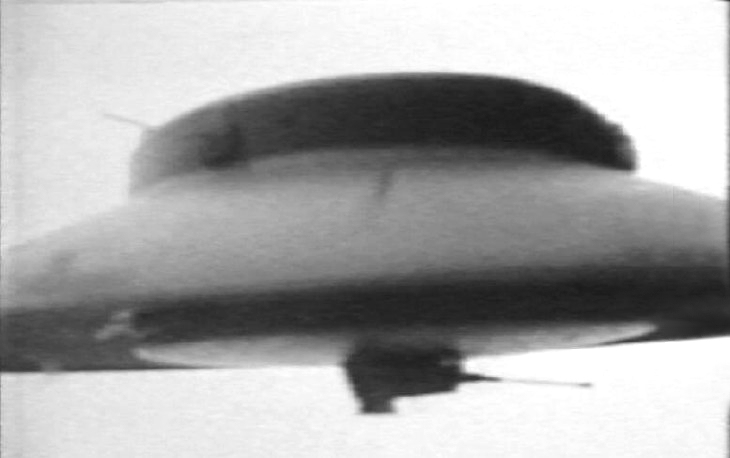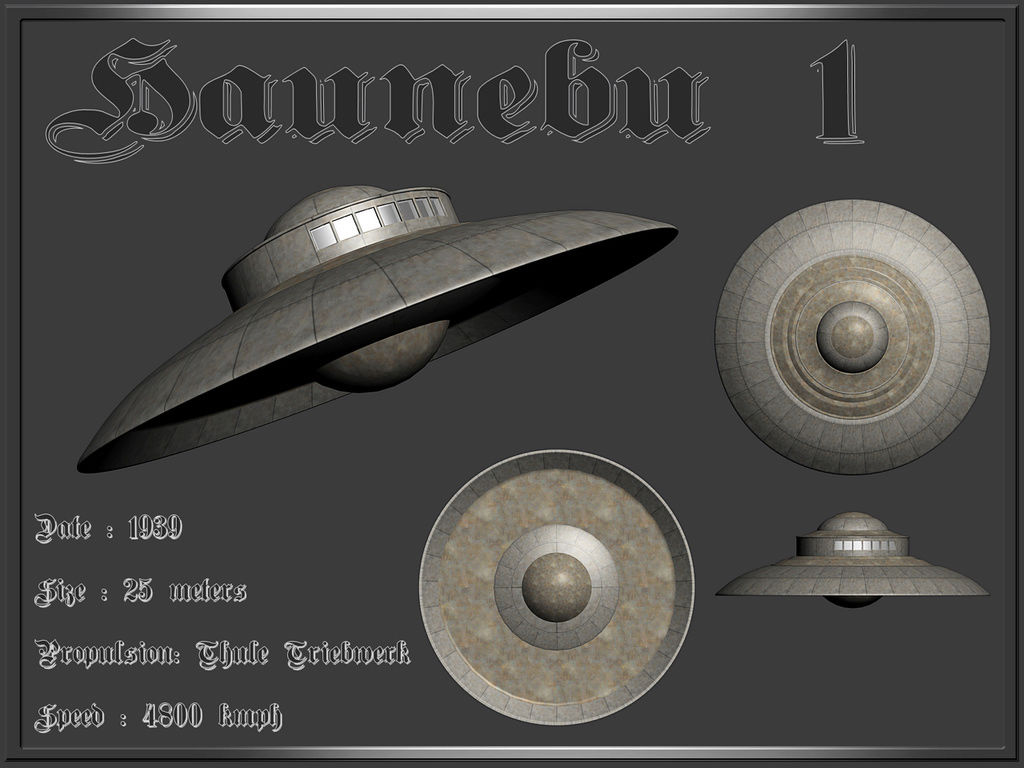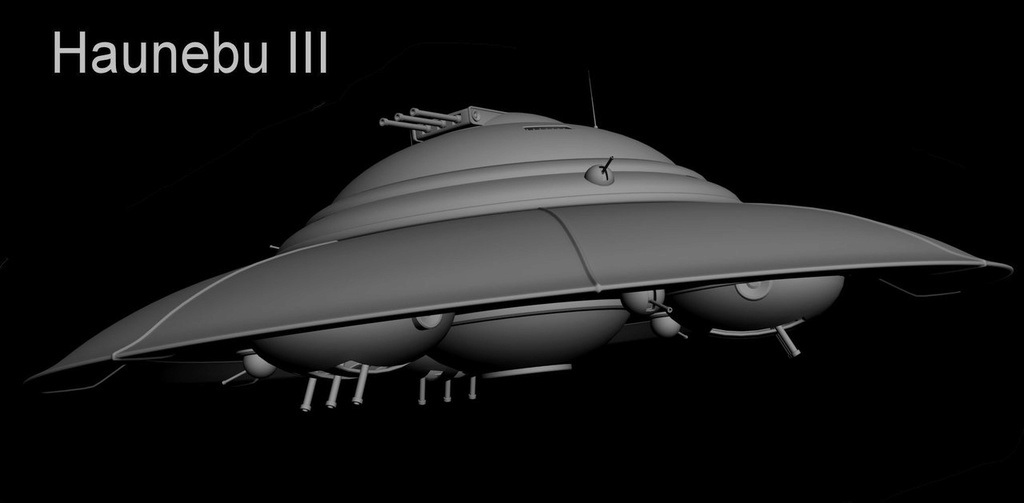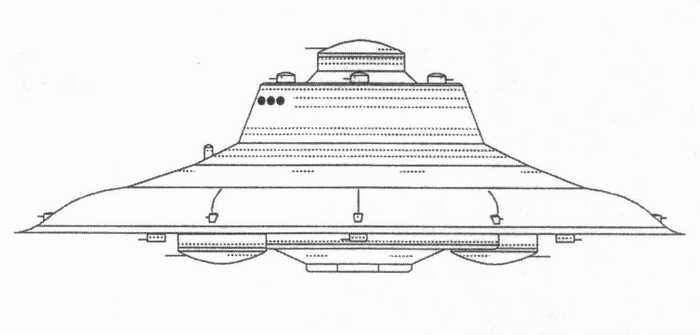'HAUNEBU' or UFOs Nazi Gestapo secret weapon.
หน้า 1 จาก 1
 'HAUNEBU' or UFOs Nazi Gestapo secret weapon.
'HAUNEBU' or UFOs Nazi Gestapo secret weapon.

HAUNEBU
(H-GERÄT, HAUNEBURG DEVICE)
(1939-1945)

The SS E-IV [Entwicklungsstelle 4], a development unit of the SS occult “Order of the Black Sun” was tasked with researching alternative energies to make the Third Reich independent of scarce fuel oil for war production. Their work included developing alternative energies and fuel sources through coal gasification, research into grain alcohol fuels, less complicated coal burning engines for vehicles and generators, as well as highly advanced liquid oxygen turbines, total reaction turbines, AIP [Air Independent Propulsion] motors and even EMG [Electro-Magnetic-Gravitic] engines.
This group developed by 1939 a revolutionary electro-magnetic-gravitic engine which improved Hans Coler’s free energy machine into an energy Konverter coupled to a Van De Graaf band generator and Marconi vortex dynamo [a spherical tank of mercury] to create powerful rotating electromagnetic fields that affected gravity and reduced mass. It was designated the Thule Triebwerk [Thrustwork, a.ka. Tachyonator-7 drive] and was to be installed into a Thule designed disc.
Since 1935 Thule had been scouting for a remote, inconspicuous, underdeveloped testing ground for such a craft. Thule found a location in Northwest Germany that was known as [or possibly designated as] Hauneburg. At the establishment of this testing ground and facilities the SS E-IV unit simply referred to the new Thule disc as a product - the "H-Gerät" [Hauneburg Device].
For wartime security reasons the name was shortened to Haunebu in 1939 and briefly designated RFZ-5 along with Vril‘s machines. At a much later time in the war as production of these craft was to commence the Hauneburg site was abandoned in favor of the more suitable Vril Arado Brandenburg aircraft testing grounds. Although designated as part of the RFZ series the Haunebu disc was actually a separate Thule product constructed with the help of the SS E-IV unit while the RFZ series were primarily built at Arado Brandenburg under Vril direction up to the RFZ-4 disc.
The early Haunebu I craft of which two prototypes were constructed were 25 meters in diameter, had a crew of eight and could achieve the incredible initial velocity of 4,800 km/h, but at low altitude. Further enhancement enabled the machine to reach 17,000 km/h! Flight endurance was 18 hours. To resist the incredible temperatures of these velocities a special armor called Victalen was pioneered by SS metallurgists specifically for both the Haunebu and Vril series of disc craft. The Haunebu I had a double hull of Victalen. The early models also attempted to test out a rather large experimental gun installation - the twin 60mm KraftStrahlKanone [KSK] which operated off the Triebwerk for power. It has been suggested that the ray from this weapon made it a laser, but it was not.




Donar [Thunder] KraftStrahlKanone
Contray to popular reports the KSK [Kraftstrahlkanone] was not a crude laser weapon able to penetrate 100mm of armor. It was a crude phaser [PHASed Energy Rectifier] that ran off the Thule Triebwerk - as such, the Haunebu and Vril craft had to hover and divert high voltage energy from the EMG engines to ball cascade oscillators that flowed down to two charged barrels wrapped in precision tungsten spirals capable of absorbing a lot of heat. The power could be changed so it was a phaser weapon.
On the Haunebu I the upside down looking tank turret is not - close ups show piping running into two elongated 60mm guns that had shrouds over them.
The escape hatch is present because the gunner sat apart in the turret, but this matches NO German tank turret at all, not even the Kugelblitz which wasn't around in 1939 anyway. But because the KSK guns caused both vulnerability and instability, they were dropped in favor of MK installations in the Vril 7 Geist and Vril 8 Odin which had an operating Oberon automated system above the control tower.
The MK 108 30mm blowback autocannon was mounted in subsequent versions of Haunebu and Vril disks. It had been manufactured in Germany during the war by Rheinmetall-Borsig for use in aircraft. The cannon measured 1057 mm length and weighted 58 kg. Its rate of fire was of 650 rounds per minute with a muzzle velocity of 540 m/s. Because of its slow muzzle velocity the cannon was difficult to aim and its range too short. However it proved to be very effective, reliable and easy to manufacture.


When a Vril 7 was downed by the Russians in 1945 a similar underbelly mounted KSK gun was destroyed with debris recovered from the battle site. Postwar the strange metal balls and tungsten spirals that made up the weapon could not be identified. But recently it has been speculated that the Triebwerk-connected balls formed cascade oscillators that were connected to a long barrel-shrouded transmission rod wrapped in a precision tungsten spiral, or coil to transmit a powerful energy burst suitable to pierce up to 4” of enemy armor! The heavy gun installation, however, badly destabilized the disc and in subsequent Haunebu models lighter MG and MK cannon were supposedly installed [although it is not apparent from any photographic source, being an internal installation of six MK-108s in an upper and lower triple gun pack]. The Haunebu I first flew in 1939 and both prototypes made 52 test flights.
In 1942, the enlarged Haunebu II of 26 meters diameter was ready for flight testing. This disc had a crew of nine and could also achieve supersonic flight of between 6,000-21,000 km/h with a flight endurance of 55 hours. Both it and the further developed 32 meter diameter Do-Stra had heat shielding of two hulls of Victalen. Seven of these craft were constructed and tested between 1943-44. The craft made 106 test flights.

Illustration of inner workings of the Haunebu III
By 1944, the perfected war model, the Haunebu II Do-Stra [Dornier STRAtosphären Flugzeug] was tested. Two prototypes were built. These massive machines, several stories tall, were crewed by 20 men. They were also capable of hypersonic speed beyond 21,000 km/h. The SS had intended to produce the machines with tenders for both Junkers and Dornier but in late 1944/early 1945 Dornier was chosen. The close of the war, however, prevented Dornier from building any production models.Yet larger still was the 71 meter diameter Haunebu III. A lone prototype was constructed before the close of the war. It was crewed by 32 and could achieve speeds of between 7,000 - 40,000 km/h! It had a triple Victalen hull. It is said to have had a flight endurance of between 7-8 weeks! The craft made 19 test flights. This craft was to be used for evacuation work for Thule and Vril in March 1945. Named Ostara, after the old Germanic goddess of the East, dawn, rebirth, and resurrection, the overloaded Haunebu III may have been boostered by a cluster of A-9/A-10 rockets to get it into the air with SS General Hans Kammler onboard.
Subsequent postwar claims that this craft was ultimately used for a suicide mission to Mars is completely unfounded; even with onboard SS oxygen generators and modified Draeger Werke pressure suits there is no way this machine could withstand an eight month journey to Mars. What would be the purpose anyway? The Gesellschaften were aiming at channeled flight not conventional space flight.

Illustrations of Haunebu III on the ground and in the air in 1945
Further plans for a 120 meter diameter Haunebu IV were in the works but no such craft is known to have been constructed before the end of the war. However, many Haunebu craft were spotted over occupied Germany in the years to follow - among them, a craft strongly resembling the Haunebu IV by the Bundeswehr in the 1970s. It is believed that all of the mysterious Haunebu craft were evacuated to a sanctuary outside of Third Reich borders; to Neu Schwabenland, Antarctica - Base 211, constructed during the war.
In the years following the close of WW2, many Haunebu-shaped disc craft have been spotted all over the world leading to speculation that either the Third Reich survived in another part of the world (primarily in Argentina) or that the victorious Allies had captured the Thule and Vril technology and constructed similar craft.
The BRD [Federal Republic of Germany] is also suspected of retaining Thule and Vril technology with official designations of FU-1 and FU-2 (Fliegende Untertassen 1 & 2).

HAUNEBU I
Moderately Armed Flight Gyro
Diameter: 24.95 m
Drive: Thule Tachyonator (Triebwerk) 7b
Control: Mag Field Impulser 4
Speed: 4,800 km/h (theoretically up to 17,000 km/h)
Range: Flight time of 18 h
Armament: 2 x 80 mm KSK in rotating turret
4 x MK-108 in body
Armor: Double Victalen
Crew: 8
Hovering capability: 8 minutes
All weather, day and night, capability
Employment fitness: 60%
First flight: 1939
Available for service: 1944

HAUNEBU III
Heavily Armed Flight Gyro
Diameter: 26.3m/ 32.0 m Do-Stra
Drive: Thule Tachyonator (Thule Triebwerk) 7c
Control: Mag Field Impulser 4a
Speed: 6,000 km/h (theoretically up to 21,000 km/h)
Armament: 6 x 80 mm KSK in 3 rotating turrets
1 x 110 mm KSK in 1 rotating turret
Armor: Triple Victalen
Crew: 9 (with room for up to 20 people)
Quiet flight: 19 minutes
All weather, day and night, capable
Employment fitness: 100%
First flight: 1942
Available for service: 1944

HAUNEBU III
Heavily Armed Flight Gyro
Diameter: 71 m
Drive: Thule Tachyonator (Thule Triebwerk) 7c plus SM-Levitators
Control: Mag Field Impulser 4a
Speed: 7,000 km/h (theoretically up to 40,000 km/h)
Range: Flight time 7 to 8 weeks
Armament: 4 x 110 mm KSK in 4 rotating turrets (3 lower/1 upper)
10 x 80 mm KSK in rotating turrets plus 6 x MK 108
8 x 50 mm KSK
Armor: Triple Victalen
Crew: 32 (with room for up to 70 people)
Quiet flight: 25 minutes
All weather, day and night, capability
Employment fitness: 100%
First flight: 1945

HAUNEBU IV
Heavily Armed Flight Gyro
Diameter: 120 m
Construction only projected for 1946
Senator Richard Russell served 38 years in the Senate, and was its senior, and one of the most influential, senators at the time of his death in 1971. He was chairman of the Armed Services Committee from 1951 to 1969, and unsuccessfully sought the Democratic Presidential nomination in 1952.
A report, classified Top Secret until 1959, when it was downgraded to Secret. and not released until 1985. detailing his UFO encounter was made available by the Fund for UFO Research and its chairman, Dr. Bruce Maccabee. Several key documents were obtained by the group through the Freedom of Information Act..
"The three observers were firmly convinced that they saw a genuine flying disc," says the Air Force Intelligence report, dated 14 October 1955.
It goes on to say Russell and his two traveling companions spotted the UFOs on 4 October 1955, while traveling by rail across Russia's Transcaucasus region.
"One disc ascended almost vertically, at a relatively slow speed, with its outer surface revolving slowly to the right, to an altitude of about 6000 feet, where its speed then increased sharply as it headed north."
The second flying disc was seen performing the same actions about one minute later. The take-off area was about 1-2 miles south of the rail line.
Russell "saw the first flying disc ascend and pass over the train," and went "rushing in to get Mr Ruben Efron, his interpreter] and Col. E. U. Hathaway, his aide to see it," the report says. "Col. Hathaway stated that he got to the window with the Senator in time to see the first [UFO], while Mr. Efron said that he got only a short glimpse of the first. However, all three saw the second disc and all agreed that they saw the same round, disc-shaped craft as the first".
The Air Force report was written by Lieut. Col. Thomas Ryan, who interviewed Senator Russell's companions in Prague, Czechoslovakia, on 13 October, after they arrived there from Russia shortly after the sighting.
In his report, Col. Ryan called the sightings "an eyewitness account of the ascent and flight of an unconventional craft by three highly reliable United States observers. He added that Col. Hathaway led off his account of the sightings by saying: "I doubt if you’re going to believe this, but we all saw it. Senator Russell was the first to see this flying disc. We've been told for years that there isn't such a thing, but all of us saw it".
CIA documents show that the agency later interviewed the three eyewitnesses in the Russell party-and also a fourth person, who had seen the UFOs -whose name was blacked out on the CIA report prior to its declassification.
Interpreter Ruben Efron told the CIA that visibility was excellent. As one UFO approached the train, he said, "the object gave the impression of gliding. No noise was heard and no exhaust was heard, and no exhaust glow or trail was seen by me." After the encounter, Senator Russell told the men with him: "We saw a flying disc. I wanted you boys to see it so that I would have witnesses," according to the CIA documents. And an FBI memo, dated 4 November 1955, also discusses the sighting-and admitted Col. Hathaway's testimony "would support existence of a flying disc."
Klaus Habermohl, a BMW engineer who worked as part of the Flugzeug Special Projects Group in Prague, was captured by the Russians in Prague on or about 11 May 1945. He undoubtedly helped the construction of a Soviet disc and I recently came across plans for another Soviet low aspect aircraft that would have used Nuclear propulsion. I do not know whether this worrying development ever got off the drawing board.
What I do know is that Senator Russell and his party saw a flying disc during a trip to the USSR in 1955 and that his most credible sighting was swept under the carpet by the same military intelligence personnel with knowledge both of unconventional US and Soviet aircraft. I very much doubt whether Russell and his party saw the disc by accident. There were many elements to the ongoing struggle between the Soviet and US military and their intelligence machines and this is reflected in several texts including John Ranelagh's definitive book "The Agency" [Sceptre 1988]. Check out the few CIA documents in its popular 'UFO Documents' collection and note the near hysteria about advanced Soviet aircraft and intentions.
Perhaps the most important and hidden aspect of this was the increasing threat of Soviet penetration of US airspace via Alaska. In any case the CIA was most concerned about "non-conventional air vehicles" under development by the Soviets as the 14 June 1954 memorandum entitled 'Intelligence Responsibilities for Non-Conventional Types of Air Vehicles' makes very clear.
...Thegreyth
หน้า 1 จาก 1
Permissions in this forum:
คุณไม่สามารถพิมพ์ตอบ